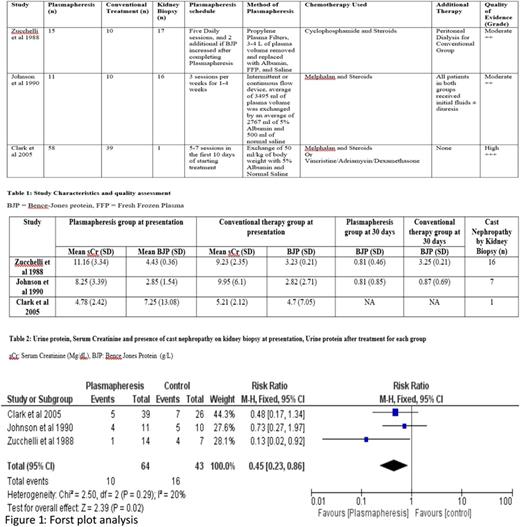Abstract
Introduction:
Cast nephropathy is the most form of kidney disease in patients with multiple myeloma and it can be associated with worse prognosis. To this date, the role of plasmapheresis in this patient population remains unclear with conflicting evidence. We performed this meta-analysis and reviewed the available evidence for the effect of plasmapheresis in myeloma patients with cast nephropathy
Methods:
Protocol registered at PROSPERO 2016 (CRD42016033377). We searched PubMed, Embase, Medline, and Cochrane library for all eligible randomized controlled trials which looked into the role of plasmapheresis in cast nephropathy patients from 1980 to 2017. Eligible studies were reviewed separately by 2 authors and any conflict was resolved by referring to a third author. Our search strategy resulted in a total of 511 articles. We screened the titles and abstracts for relevance. English only randomized controlled trials which looked into the effect of plasmapheresis on renal outcome in cast nephropathy patients were considered. A full text was obtained in case of uncertainty about the content. We used the Cochrane's tool for risk of bias and quality assessment. Studies were reviewed and data was extracted independently by two authors, and final judgment was made after collaboration between authors. A confirmed diagnosis of multiple myeloma with myeloma kidney disease as evidenced by either presence of high light chain concentration in the urine or by kidney biopsy was required to include patients in our analysis. Six controlled trials were initially identified of which 3 were excluded since they were early reports of a larger trial. Three trials were included in our final analysis based on the inclusion criteria. Our primary outcome was to assess the risk of dialysis dependence at 6 months cast nephropathy patients when treated with plasmapheresis along with chemotherapy compared to those who do not receive plasmapheresis. Secondary outcome was to assess mortality at 6 months for both groups. Data analysis was performed using Review Manager version 5.3.5. The measurement of effect was done by calculating the risk ratio and 95% confidence interval using a fixed-effect Mantel-Haentszel method. We assessed for heterogeneity using Mantel-Haentszel chi-square test and I2 test.
Results:
A total of 147 patients were analyzed in this study (84 patients in the plasmapheresis group and 63 patients in the chemotherapy group). Plasmapheresis treatment schedule varied between the studies, and ranged between 4 and 7 sessions. Table 1 summarizes the included studies, and table 2 shows serum creatinine level, presence of cast nephropathy at presentation, and urine protein level at presentation and after treatment for each group.
There was a significantly lower risk of dialysis dependence in the plasmapheresis group compared to the control group (Risk Ratio = 0.45; 95% CI, 0.23-0.86, P = 0.02), (Figure 1). No statistically significant difference in mortality risk at 6 months was found between the 2 groups; 22 patients died in the plasmapheresis group compared to 19 patients in the control group (Risk Ratio = 0.83; 95% CI, 0.49-1.40, P = 0.49).
Discussion:
Early reduction of free light chains has been shown to be associated with improved renal recovery. Using plasmapheresis along with chemotherapy to achieve this early reduction is one of the methods that has been evaluated in several studies, with variable results. The Myeloma and Renal Impairment Trial investigating the use of dexamethasone and chemotherapy with or without plasmapheresis in patients with newly diagnosed multiple myeloma and acute kidney failure, was supposed to be the largest randomized controlled trial to date. Unfortunately it closed prematurely due to slow recruitment. It is important to note that all trials were done before the introduction of proteasome inhibitors and immunomodulators, which has changed the course of multiple myeloma, and significantly improved complete remission, time to progression, progression free survival, and overall survival compared to conventional chemotherapy. Despite the conflicting evidence of plasmapheresis benefit in cast nephropathy patients, it still might be beneficial in some cases with biopsy proven cast nephropathy when possible and only after prompt initiation of chemotherapy. High-cutoff dialysis might be another promising alternative and clinical trials assessing this method are under the way.
No relevant conflicts of interest to declare.
Author notes
Asterisk with author names denotes non-ASH members.


This feature is available to Subscribers Only
Sign In or Create an Account Close Modal